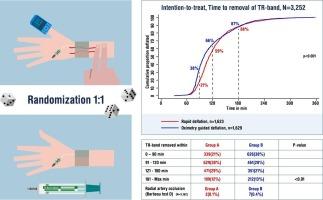Randomized comparison of rapid versus oximetry guided deflation of the transradial-band after coronary angiography or angioplasty
IF 3.2
2区 医学
Q2 CARDIAC & CARDIOVASCULAR SYSTEMS
引用次数: 0
Abstract
Background
Transradial access is recommended for coronary angiography and angioplasty, and is associated with fewer complications when compared to femoral access. Nevertheless, there is a risk of hematoma and radial artery occlusion (RAO), and substantial time may elapse until hemostasis is achieved.
Aims
We aimed to evaluate if an oximetry-guided deflation technique compared to a traditional rapid deflation technique was associated with earlier removal of the transradial band (TR-band) and lower rates of RAO following radial coronary intervention.
Methods
Between October 2018 and December 2021, we randomized 3600 patients to either traditional rapid deflation where 1/3 of volume in the TR-band was removed every 20 min and reinflated if bleeding, or oximetry-guided deflation aiming at patent hemostasis and full deflation of the TR-band after 60 min, with cross-over to traditional deflation if bleeding at the time of deflation.
Results
A TR-band was applied in 3540 patients, and data on time to removal was available in 3288 (93 %) of these. The time to full deflation of the TR-band was 92 versus 74 min, P < 0.01 and the time to removal of the TR-band was 112 versus 100 min, P < 0.01 in patients randomized to traditional rapid (n = 1767) versus oximetry-guided deflation (n = 1773). The rate of RAO or sub- occlusion evaluated by oximetry after TR-band removal was 1.2 % versus 1.8 %, P = 0.16.
Conclusion
Traditional rapid deflation of the TR-band with the first deflation attempt after 20 min is associated with re-bleeding and prolonged time to removal of the TR-band, as compared to a strategy where the first deflation attempt is performed after 60 min. Oximetry-guided deflation, however, was not associated with lower rates of RAO or subocclusion.

冠状动脉造影术或血管成形术后经桡动脉带快速放气与血氧饱和度引导放气的随机比较。
背景:经桡动脉入路被推荐用于冠状动脉造影和血管成形术,与股动脉入路相比,经桡动脉入路并发症较少。然而,经桡动脉入路存在血肿和桡动脉闭塞(RAO)的风险,而且在止血之前可能需要很长时间。目的:我们旨在评估与传统的快速放气技术相比,血氧饱和度指导下的放气技术是否与经桡动脉带(TR-band)的提前移除和桡动脉冠状动脉介入术后 RAO 的较低发生率有关:在2018年10月至2021年12月期间,我们对3600名患者进行了随机分组,分别采用传统的快速放气技术(每20分钟移除经桡动脉带1/3的容量,如果出血则重新充气)或血氧饱和度引导放气技术(以止血通畅为目标,60分钟后完全放气经桡动脉带,如果放气时出血则交叉至传统放气技术):3540名患者使用了TR带,其中3288名患者(93%)获得了移除时间的数据。TR-束带完全放气的时间为 92 分钟对 74 分钟(P与 60 分钟后首次尝试放气的策略相比,传统的快速 TR 带放气(20 分钟后首次尝试放气)与再出血和 TR 带移除时间延长有关。然而,血氧饱和度指导下的排气与 RAO 或亚闭塞发生率降低无关。
本文章由计算机程序翻译,如有差异,请以英文原文为准。
求助全文
约1分钟内获得全文
求助全文
来源期刊

International journal of cardiology
医学-心血管系统
CiteScore
6.80
自引率
5.70%
发文量
758
审稿时长
44 days
期刊介绍:
The International Journal of Cardiology is devoted to cardiology in the broadest sense. Both basic research and clinical papers can be submitted. The journal serves the interest of both practicing clinicians and researchers.
In addition to original papers, we are launching a range of new manuscript types, including Consensus and Position Papers, Systematic Reviews, Meta-analyses, and Short communications. Case reports are no longer acceptable. Controversial techniques, issues on health policy and social medicine are discussed and serve as useful tools for encouraging debate.
 求助内容:
求助内容: 应助结果提醒方式:
应助结果提醒方式:


